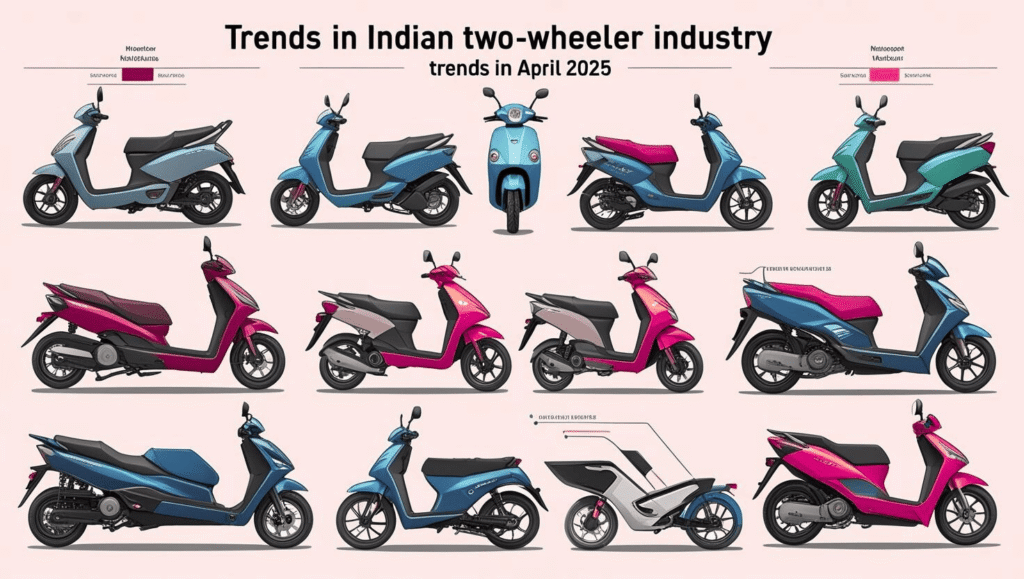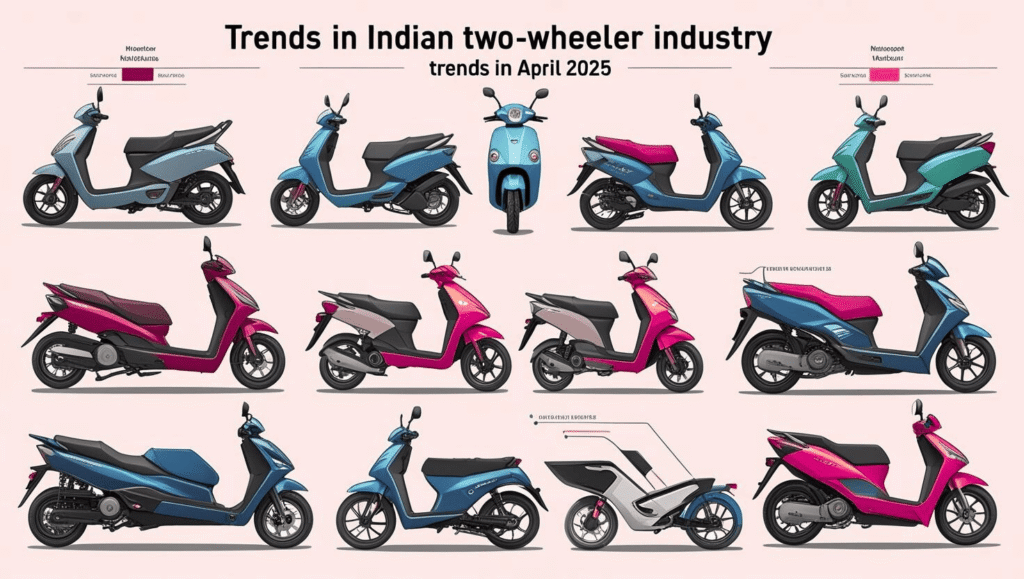Imagine navigating the crowded streets of Delhi or weaving through Bengaluru’s traffic. What’s the one vehicle you’re most likely to see? The humble two wheeler. In April 2025, the two wheeler market in India continues to play a pivotal role in everyday mobility, employment, and even emotional identity for millions. But beyond the horns and helmets lies a fiercely competitive, ever-evolving landscape that tells a deeper story about India’s economic pulse and consumer sentiment.
In this post, we explore the current two wheeler market share in India April 2025, breaking down the latest numbers, industry shifts, and emerging trends that are steering the market in new directions.

The Big Picture: Market Overview April 2025
As per SIAM’s latest vehicle sales data, the two wheeler industry recorded a sales volume of approximately 16.7 lakh units in April 2025, marking a 6.3% year-on-year growth. This growth has been fueled by rising disposable income, improved rural demand, and a noticeable shift in consumer preference toward fuel-efficient and electric variants.
Market Share Snapshot: Top OEMs
| Manufacturer | Market Share (April 2025) | April 2024 Share | Key Highlights |
|---|---|---|---|
| Hero MotoCorp | 33.5% | 34.7% | Strong rural base, slight dip due to EV lag |
| Honda Motorcycle | 27.2% | 25.6% | Growing Activa and CB series demand |
| TVS Motor Company | 15.6% | 14.8% | Strength in EV segment with iQube |
| Bajaj Auto | 11.1% | 12.0% | Pulsar sales stable, Chetak EV gaining pace |
| Royal Enfield | 4.8% | 5.3% | Minor slump, yet strong niche appeal |
| Others (incl. EVs) | 7.8% | 7.6% | Ola, Ather, Revolt expanding footprint |
Hero vs. Honda: A Classic Rivalry Reignited
Hero MotoCorp has historically dominated the commuter segment, but its over-dependence on petrol bikes like the Splendor and Passion is starting to show cracks. While Hero still leads the market, Honda’s aggressive push with the Shine 125 and the consistent popularity of the Activa series has narrowed the gap.
Personal Take: Field Perspective
Working in the Hero MotoCorp ecosystem, we’ve noticed a clear shift in urban customers leaning toward Honda, citing smoother performance and refined styling. In contrast, rural consumers still swear by the fuel efficiency and ruggedness of Hero’s offerings. The key challenge for Hero will be accelerating its EV portfolio and matching Honda’s growing brand value.
Rise of the EVs: Not Just a Buzzword Anymore
The biggest shake-up in April 2025 has come from the electric two wheeler segment. Brands like TVS, Ola Electric, and Ather Energy are not just filling niches—they’re reshaping them.
Top EV Performers in April 2025:
- TVS iQube: Record sales in Tier-1 and Tier-2 cities
- Ola S1 Pro: Leading in direct-to-customer model
- Ather 450X: Known for tech-savvy buyers and superior ride experience
Despite infrastructure limitations, EVs now contribute to 6.2% of total two wheeler sales, up from 3.9% a year ago. The government’s continued FAME-II subsidies and the growing charging ecosystem are key contributors to this rise.
Regional Trends: North vs. South vs. East vs. West
- North India (Delhi, Punjab, UP): Still loyal to 100-125cc petrol bikes. Hero dominates.
- South India (TN, Karnataka): Early EV adopters. TVS and Ola are gaining traction.
- West India (Maharashtra, Gujarat): Performance bikes and EVs showing parallel demand.
- East India (Bihar, WB): Price-sensitive, mileage-focused buyers. Hero and Honda rule here.
Insight: Regional showrooms report that areas with better EV infrastructure are seeing a sharp uptick in electric two wheeler interest.
What’s Fueling the Growth?
- Fuel Prices: Continuous petrol price fluctuations are nudging buyers towards EVs.
- Financing Options: More NBFCs and digital lenders are offering low-cost EMI plans.
- Product Innovation: More scooters with Bluetooth, GPS, and digital consoles.
- Government Policy: Incentives on EVs, push for local manufacturing (PLI scheme).
Bonus Insight:
Manufacturers offering quick delivery timelines and low-cost servicing are witnessing significantly better conversion rates in semi-urban and rural areas.
Challenges in the Two Wheeler Segment
- Supply Chain Issues: Chip shortages are still affecting premium variants.
- EV Infrastructure: Inadequate charging stations in smaller towns.
- Consumer Trust: Especially in EVs, due to battery fire incidents and range anxiety.
Despite these hurdles, brands that offer consistent after-sales support and transparency are building long-term trust.
Future Outlook: May 2025 and Beyond
Industry experts forecast a double-digit growth for the two wheeler segment in FY 2025-26. Key expected developments:
- Hero’s EV Launch: All eyes on their upcoming Vida EV series expansion
- Ola’s Rural Penetration Strategy: Could be a game changer
- TVS and Honda’s R&D investments: Expected to bring hybrid models by year-end
Conclusion: Wheels of Change Are in Motion
The two wheeler market share in India April 2025 isn’t just a number game. It’s a reflection of how India moves, aspires, and adapts. As market leaders face new competition and electric vehicles begin to shape urban and rural choices alike, one thing is clear: the two wheeler remains a vital gear in India’s economic and cultural engine.
Call to Action:
Are you a dealer, enthusiast, or buyer? Share your experience with two wheelers in your city. Do you see more EVs on the road? Which brand do you trust and why? Let us know in the comments or explore our detailed guides on best electric scooters in India and fuel-efficient motorcycles for 2025!
